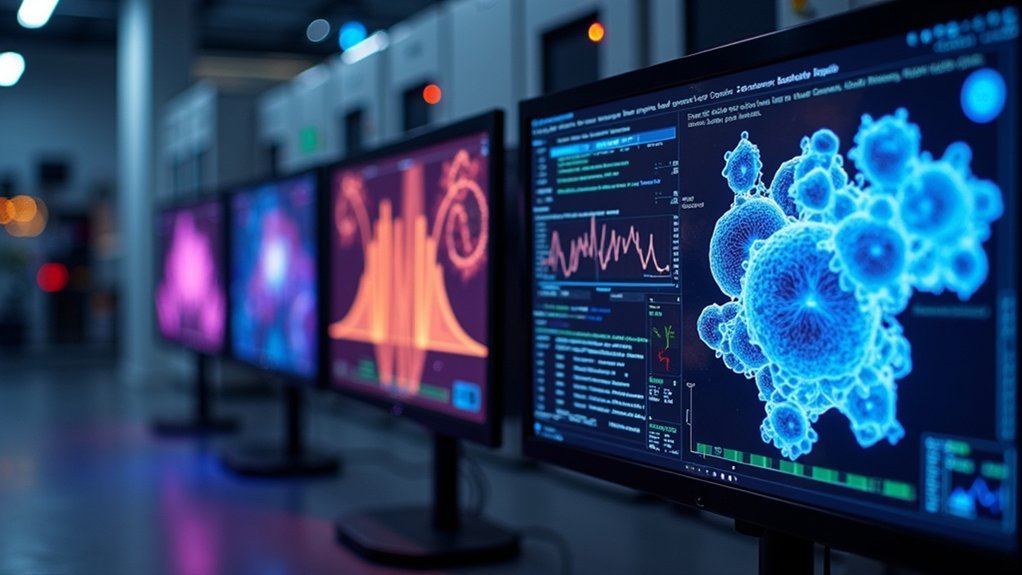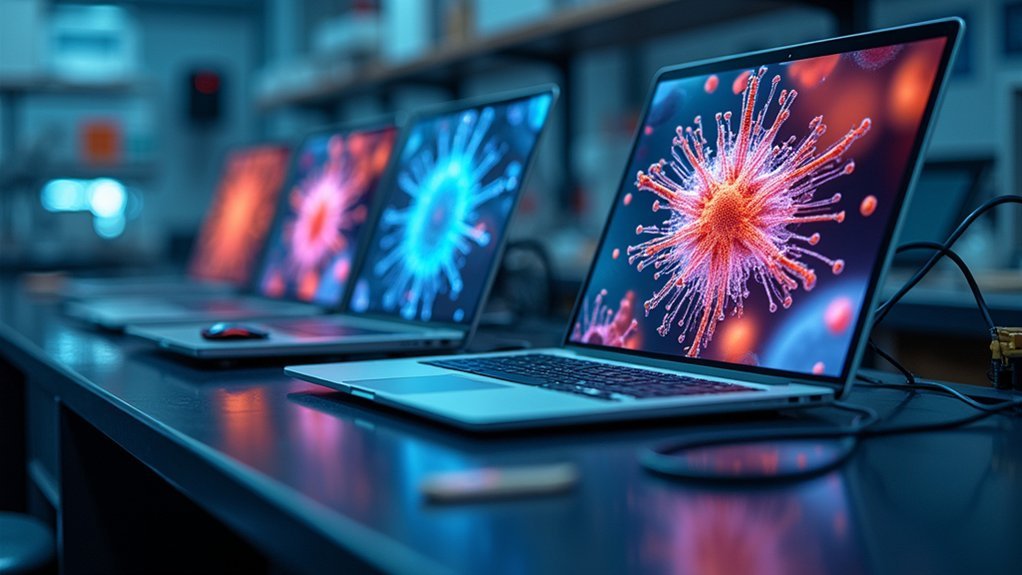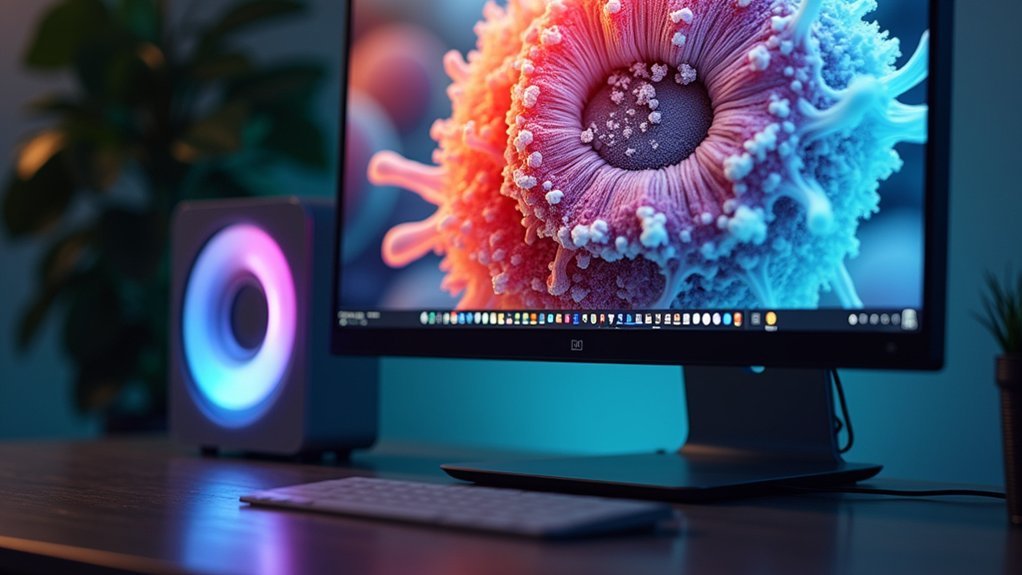Scientists convert images between formats to meet diverse research needs. You’ll need TIFF for preserving raw data integrity, PNG for presentations with transparency, and JPEG for easy sharing. Different formats offer unique advantages in bit depth, metadata retention, and compression options that impact analysis quality. Specialized formats like FITS support advanced scientific requirements that consumer formats can’t handle. Understanding these distinctions helps you maintain data integrity throughout your research workflow.
Why Convert Scientific Images Between Multiple File Formats?

When working with scientific images, you’ll often need to convert between different file formats to meet various research needs. Each image file format serves a specific purpose in your scientific workflow. For instance, TIFF provides lossless compression essential for preserving data integrity during analysis, while JPEG’s efficiency makes it ideal for online sharing with colleagues.
Converting between formats guarantees your images remain compatible with diverse software and platforms, facilitating seamless collaboration.
You’ll appreciate how formats like FITS incorporate valuable metadata that enhances data management and retrieval. Additionally, when preparing your research for publication, converting to specialized formats like PNG or PDF can maintain visual clarity and transparency.
Understanding the Unique Properties of Scientific Image Formats
Scientific image formats differ fundamentally in their capabilities and designed purpose, with specialized formats offering features you won’t find in common consumer formats. When working with scientific images, you’ll need formats that preserve data integrity and contextual information.
| Format | Bit Depth | Metadata Support | Compression Type |
|---|---|---|---|
| FITS | 12+ bits | Unlimited | Lossless |
| JPEG | 8 bits | Limited | Lossy |
| PNG | 8-16 bits | Basic | Lossless |
| TIFF | Up to 32 | Good | Both options |
| RAW | 12-14 bits | Limited | Lossless |
FITS files, the gold standard in astronomy since 1981, support floating-point values and three-dimensional data volumes. Unlike consumer formats, they maintain complete data integrity while storing extensive acquisition parameters needed for proper scientific analysis.
Preserving Data Integrity During Format Conversion

You’ll need to carefully assess potential data loss when converting scientific images between formats, particularly checking for preservation of bit depth, intensity values, and spatial resolution.
Running checksum verification on both source and converted files can identify corruption or alterations that might jeopardize your research.
Compare histograms and perform pixel-by-pixel analyses to guarantee critical scientific information hasn’t been compromised during the conversion process.
Data Loss Assessment
As researchers convert images between different file formats, understanding potential data loss becomes essential for maintaining scientific integrity.
When you convert scientific images, you’re making critical decisions about data preservation. Converting from high to lower bit-depth formats (like 16-bit TIFF to 8-bit JPEG) notably reduces intensity information and grey levels, compromising your analysis.
To properly assess potential data loss, you should evaluate whether you’re using a lossless format like TIFF or FITS, which preserves all original data, or lossy formats like JPEG, which discard information during compression.
Additionally, check if your conversion process maintains critical metadata that documents acquisition parameters. The safest approach is archiving your original images in lossless formats to guarantee you can always return to uncompromised data for future analysis.
Verification Methods
To guarantee your scientific images remain faithful to the original data after format conversion, you must implement robust verification methods. Without proper checks, you’ll risk significant loss of information that could compromise your research integrity.
| Verification Method | Purpose |
|---|---|
| Bit Depth Validation | Confirms preservation of quantitative data resolution |
| Checksum Verification | Detects any alterations in data during conversion |
| Metadata Inspection | Verifies retention of acquisition parameters |
| Visual Assessment | Identifies artifacts or detail degradation |
| Specialized Software | Utilizes tools designed for scientific image integrity |
Always verify your converted images using multiple approaches. By combining automated checksums with careful visual inspection, you’ll catch both computational errors and perceptual changes. When converting between formats like TIFF and JPEG, remember that specialized scientific software often provides superior conversion algorithms that prioritize data integrity over file size reduction.
Optimizing File Sizes Without Compromising Quality
You’ll find lossless compression formats like PNG and TIFF essential for preserving image integrity while still reducing file sizes for scientific images.
When balancing resolution against storage needs, consider maintaining original high-resolution files in lossless formats while creating lower-resolution copies for presentations or sharing.
Tools that support batch processing can help you efficiently manage this workflow, allowing you to optimize hundreds of images while maintaining appropriate quality levels for each intended use.
Lossless Compression Techniques
The preservation of data integrity stands as the cornerstone of scientific image management. When you’re working with critical research images, lossless compression techniques like LZW and ZIP offer the perfect balance between file size reduction and quality preservation.
Unlike lossy methods that degrade with each save, lossless compression maintains every pixel’s original value. This is why formats such as TIFF and PNG are ideal for scientific applications—they allow you to edit and save repeatedly without introducing artifacts or compromising precision.
You’ll find this particularly valuable when working with high bit-depth images (like 16-bit TIFFs) that capture extensive intensity ranges.
Resolution vs. Storage
While lossless compression helps preserve data integrity, managing the fundamental relationship between resolution and storage presents another challenge for scientific researchers.
You’ll often face a tradeoff between maintaining high resolution and managing file sizes efficiently.
When working with scientific images, you can optimize storage by selecting appropriate bit depth for your analysis needs. Converting from 16-bit to 8-bit formats can dramatically reduce file sizes, but you’ll need to guarantee this doesn’t compromise subtle details critical for your measurements.
Consider your workflow requirements when making format decisions. For archiving and analysis, use lossless formats with compression like LZW-compressed TIFFs.
For sharing or presenting findings, you might use more compact formats. This balanced approach guarantees you maintain data quality while effectively managing storage constraints.
Enhancing Compatibility Across Different Research Platforms

Converting scientific images to widely supported formats presents a critical advantage for researchers working across multiple platforms.
When you save your original images in common file formats like TIFF or PNG, you guarantee seamless integration with various imaging software and publication tools that often have specific format requirements.
Proprietary formats from confocal imaging equipment may limit accessibility, whereas converting to standardized formats enables broader usage across different systems.
You’ll find that JPEG and PNG optimizations work particularly well for digital presentations while maintaining analytical quality.
For publishing purposes, PDF and EPS formats provide universal compatibility, allowing you to share detailed scientific images without quality loss.
This strategic approach to file formats guarantees your valuable research data remains accessible and usable by colleagues regardless of their preferred software environment.
Converting FITS Images for Publication Requirements
As researchers prepare astronomical data for publication, FITS (Flexible Image Transport System) files must typically undergo conversion to more widely accepted formats.
You’ll need to maintain image quality while meeting journal specifications.
When converting your astronomical images, follow these essential steps:
- Select appropriate target formats – TIFF files are preferred for preserving high bit depth and detail.
- Preserve important metadata from the FITS header for proper scientific context.
- Use specialized tools like AstroPy or SAOImage DS9 to guarantee data integrity during conversion.
- Verify the specific requirements of your target journal before finalizing conversion.
This process guarantees your valuable observational data remains scientifically accurate while meeting publication standards.
Remember that different journals may have varying preferences regarding file format and compression levels.
Managing Bit Depth and Dynamic Range in Format Transitions

The change between file formats presents a vital challenge for scientific image integrity because bit depth directly impacts the quality of your research data.
Preserving bit depth during file format conversions safeguards scientific data integrity and research quality.
When you convert from higher bit depths (12 or 16-bit) to lower ones (8-bit), you’re drastically reducing the available gray levels, potentially losing subtle intensity variations essential for accurate analysis.
Your scientific measurements depend on preserving dynamic range throughout the workflow.
Converting high bit-depth images from lossless formats like TIFF to compressed formats like JPEG doesn’t just compress file size—it permanently discards information. This loss can make precise intensity measurements impossible and undermine your findings.
To maintain data integrity, always consider bit depth during format changes.
Preserve your original high bit-depth files in lossless formats, especially for archiving and any future analysis needs.
Batch Processing for Efficient Microscopy Workflow Management
You’ll save countless hours by implementing batch processing to simultaneously convert multiple microscopy images between formats rather than handling them individually.
This automated approach greatly reduces the risk of manual errors that commonly occur during repetitive file conversions, ensuring consistency across your entire dataset.
Integrating these time-saving workflows into your research routine allows you to focus on analysis and interpretation while the software efficiently manages the technical conversion tasks.
Batch Processing for Efficient Microscopy Workflow Management
When handling hundreds of microscopy images from experimental sessions, batch processing becomes an indispensable tool in your scientific workflow. Instead of converting files individually, you’ll save valuable research time by processing multiple images simultaneously.
Batch processing delivers four key benefits:
- Time efficiency – Convert and save images in various file formats simultaneously, freeing you to focus on data analysis rather than repetitive file management.
- Error reduction – Minimize mistakes by applying consistent formatting parameters across all images.
- Format consistency – Maintain uniform file formats required for publication or analysis software.
- Metadata preservation – Apply consistent scaling, compression, and metadata settings across your entire image collection.
Most modern microscopy software platforms support batch processing features, making this approach accessible for researchers at all technical levels.
Automation Reduces Manual Errors
Despite your best efforts, manual image conversion inevitably introduces inconsistencies and errors into scientific datasets. Automation through batch processing eliminates these human-induced mistakes, ensuring your microscopy workflow maintains data integrity.
When you implement automation, you’ll preserve critical metadata and apply consistent processing parameters across all files, allowing you to focus on analysis rather than formatting tasks.
| Error Type | Manual Process | Automated Solution |
|---|---|---|
| Naming errors | Inconsistent file naming | Standardized naming conventions |
| Format selection | Incorrect format choices | Pre-configured format parameters |
| Metadata loss | Incomplete information transfer | Complete metadata preservation |
| Processing inconsistency | Variable parameters | Uniform processing across files |
Time-Saving Processing Workflows
Transforming hundreds of microscopy images no longer requires hours of tedious manual work because batch processing automates the entire conversion pipeline.
You’ll dramatically improve your research productivity by implementing efficient workflow management systems that handle file format conversions automatically.
Batch processing delivers four key benefits:
- Time efficiency – Convert multiple images simultaneously while you focus on analysis
- Consistency – Guarantee uniform file format standards across your entire dataset
- Error reduction – Minimize human mistakes that occur during repetitive manual conversions
- Enhanced collaboration – Streamline sharing with colleagues by maintaining compatible formats
Maintaining Metadata Through Format Conversions
Although scientific images can be converted between various file formats for different analytical purposes, preserving the associated metadata remains critically important for research integrity.
When you’re converting from lossy compression formats like JPEG to lossless formats such as TIFF, you’ll safeguard valuable metadata that documents critical experimental conditions.
Scientific formats like FITS and TIFF excel at metadata preservation, with FITS supporting unlimited header information essential for astronomical datasets. TIFF’s tagged structure retains exposure settings and imaging techniques across conversions.
You’ll find that maintaining metadata integrity throughout format changes guarantees reproducibility in your research.
Whether you’re working with telescope information, acquisition parameters, or observational data, proper metadata handling during conversion creates consistent documentation that remains accessible across different imaging software platforms.
Selecting Appropriate Formats for Different Analysis Techniques

When you’re conducting scientific image analysis, choosing the right file format can considerably impact your results and workflow efficiency.
Different analytical methods demand specific file formats to preserve the original image integrity and facilitate accurate processing.
Choose your format based on your specific needs:
- TIFF – Ideal for archiving raw scientific data when you need lossless compression and higher bit depth for precise analysis.
- FITS – Best for astronomical data analysis with superior resolution, floating point precision, and extensive metadata.
- PNG – Perfect for publication figures requiring transparency while maintaining image quality.
- PDF/EPS – Best for publication-ready materials that need further editing and easy integration into documents.
Don’t compromise data integrity by using inappropriate file formats like JPEG for scientific analysis where precision matters.
Addressing the Limitations of Standard Consumer Image Formats
Despite their widespread use, standard consumer image formats present significant challenges for scientific imaging applications. When you’re working with scientific data, JPEG’s lossy compression and 8-bit limitation (256 gray levels) can result in vital loss of resolution and data integrity.
Similarly, PNG, while lossless, caps at 256 levels per channel, insufficient for 12-bit or 16-bit scientific imaging needs.
Both file formats fall short in metadata handling—they can’t store essential acquisition parameters, calibration data, and experimental conditions that provide necessary context for your research.
For instance, astronomical imaging often requires FITS format, which supports floating point values and higher bit depths to preserve the full range of collected data.
Converting between appropriate scientific formats rather than consumer formats guarantees you maintain the precision and context your analysis demands.
Best Practices for Converting 3D and Multi-Channel Microscopy Data
The conversion of complex 3D and multi-channel microscopy data demands specialized approaches to preserve scientific integrity. When working with these sophisticated datasets, you’ll need to prioritize file formats that maintain both bit-depth and metadata.
- Select appropriate file formats like TIFF or FITS, which excel at preserving high bit-depth (12-16 bits) and can accommodate multiple channels without data loss.
- Always utilize lossless formats during conversion to prevent degradation of critical scientific details.
- Guarantee metadata retention by choosing formats that preserve acquisition parameters and calibration information.
- Use specialized software such as FIJI or proprietary imaging tools designed specifically for handling complex microscopy data conversions.
Remember that consumer-grade formats like JPEG can’t adequately represent the complexity and precision your scientific imaging requires.
Frequently Asked Questions
Why Is It Important to Know Each File Format for Images?
Knowing image file formats helps you preserve data integrity, maintain quality, and guarantee compatibility. You’ll make better choices about compression, bit depth, and metadata that affect your analysis and publication success.
Why Do We Need Different File Formats?
You need different file formats because they’re designed for specialized purposes. Some prioritize small size for web use, others preserve quality, support transparency, or handle metadata necessary for your specific application.
Why Should You Save Images as .Tiff Files for Editing Instead of Saving Them as JPEGS?
You should save images as TIFF files for editing because they use lossless compression, support higher bit depths, preserve layers and channels, retain essential metadata, and won’t degrade with multiple saves unlike JPEGs.
How Does File Format Affect Image Quality?
File format affects your image quality considerably. Lossy formats like JPEG introduce compression artifacts, while lossless formats like TIFF preserve all details. You’ll maintain higher quality with formats that don’t discard data during saving.
In Summary
You’ll find that strategic file format conversion is vital to your scientific imaging workflow. When you convert between formats properly, you’ll preserve critical data, optimize storage, and guarantee compatibility across platforms. Don’t overlook metadata retention during conversions. By understanding each format’s strengths and limitations, you’re better equipped to select the appropriate format for your specific analysis needs and research collaboration requirements.





Leave a Reply